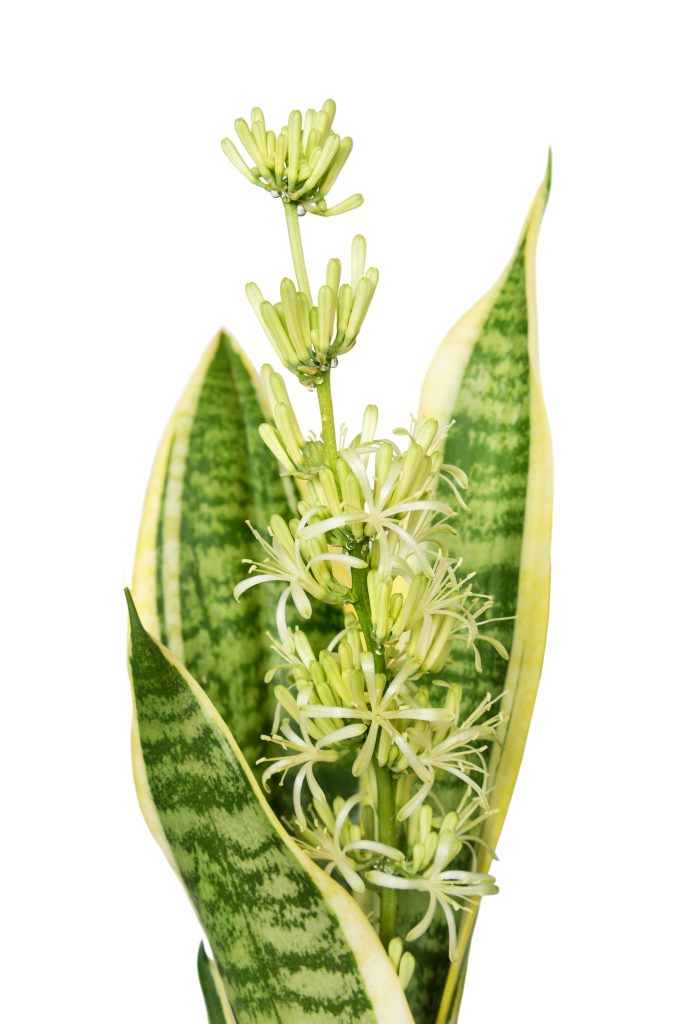One of the most popular, nearly indestructible house plants available, the snake plant benefits your home in ways you may not expect. Not only is this carefree plant great for boosting you gardening confidence, it will enliven a dim corner, thrive in a well-lit spot and has been identified by NASA as an effective plant at purifying the air. This plant offers everything! Given the right conditions they are fast growers and also have a long life-span so can be enjoyed for many years in your home.
 |
 |
 |
 |
| Light | Water | Ease of Growing | Growth Rate |
| Shade to bright light, with some sun |
Minimal watering | Very easy, great for beginners. | Fast in right conditions. |
The snake plant, also known as Sansevieria, is a type of succulent, with upright, sword-like, fleshy leaves. There are two different shapes that are common – the upright form that can grow to 3′ (1m) in height or the rosette form that is only about 6″ (15cm) tall. Their tall, thin growth makes them perfect for windowsills, hallways and any brightly lit small corners.
The most common varieties are the S. trifasciata, which has dark green leaves with greyish ‘stripes’ and the variegated plant, S. trifasciata ‘laurentii‘ bearing the same ‘striped’ leaves with beautiful, golden-edges. There are many other varieties of snake plants, some are easier to find than others. Two others worth mentioning are the Sansevieria ‘golden hahnii’ and the Sanseviera ‘cylindrica’. The golden hahnii has creamy edges on the leaves and is a rosette variety growing to about 10″ (25cm) tall. The cylindrical variety is quite unique and will grow to 20″ – 24″ (50cm – 60cm) tall with uniquely shaped leaves (see photo below).
Occasionally, sprays of small, fragrant flowers will be produced although this is not so common for house plants. The snake plant benefits from being pot bound and this may help to encourage flowering.
Snake Plant Benefits
Adaptable: Snake plants are able to grow in a variety of locations in you home. They are happy with any light condition from a couple of hours of direct sunlight to being placed near a north facing window which receives much less light.
Indestructible: You don’t need to fuss over your snake plant. It can withstand periods of dry soil and will be less appreciative of overwatering than underwatering!
Air Purifying: A report done by NASA identified variegated snake plants as being excellent air purifying plants, removing trichloroethylene, formaldehyde, benzene and xylene from the air. Not only that but they also produce oxygen at night, great to have by your bed whilst you sleep.
Fast Growers: Snake plants do grow quite quickly when given the right conditions and they usually have a long life span. A perfect plant to enjoy for years to come. The leaves grow from an underground stem which is easy to propagate, as outlined below, so before long you won’t just have one snake plant!
Interesting Varieties: If you like collecting unusual plants then there are plenty here to keep you interested.
Stylish: The upright shape of the snake plants makes them an ideal indoor plant. They keep their leaves tall and out of the way, almost like a living sculpture really. It’s easy to find a spot for one, or more, of these beautiful plants in your home.
Snake Plant Care Guide
Light
Although the snake plant benefits from bright light and some sunshine, it will continue to grow, perhaps a bit slower in dimmer light. As with all plants, it won’t survive in a windowless room. All plants do need light to photosynthesize, but the snake plant is quite tolerant of lower light levels.
Water
Being a succulent with thick, fleshy leaves that store water, the snake plant will tolerate moderately dry soil. In fact, soggy or waterlogged soil is one of the few things that will actually kill it.
Before watering your snake plant check the top couple of inches of soil with your finger. If it feels moist, wait a bit longer before watering. When watering your snake plant either water it from the base, allowing the soil to soak up the water, or water the soil, rather than the plant stem.
In winter your snake plant will benefit from much less water, only once every couple of months, just to keep the soil barely moist. Taking care not to overwater your snake plant in winter will help to prevent root rot.
Temperature and Humidity
Your snake plant will be quite happy in a home that you are comfortable in. It likes warm temperatures, moderate humidity levels and will tolerate quite dry air. The main thing is to ensure to protect it from the freezing cold (<50ºF/10ºC) as this can cause damage to your snake plant quite quickly.
Fertilizer
Fertilizer is only required during the growing season of spring to summer. A weak liquid fertilizer can be given once every month or two to encourage healthy, lush growth if the soil needs enriching.
Pruning
Pruning your snake plant is not really necessary. This really is a care-free plant! If any leaves did yellow or become unsightly they could be removed to keep the snake plant looking its best.

Snake Plant (Sansevieria) Planting Guide
Soil
One of the few problems that people might have with their snake plant is from overwatering. Because of this, your snake plant benefits from being planted in a well-draining potting mix especially formulated for cacti and succulents. A terracotta pot will also be beneficial as it allows the soil to dry out slightly.
Repotting
Your snake plant will only need repotting if it is growing out of its pot. They are quite happy to be root bound, however if you do need to repot it, spring is the best time to do this. And when replanting your snake plant, be careful not to plant it too deeply in soil as this may damage the stems.
Propagation
There are three main ways to propogate snake plants. The first is to divide the plant when repotting it, the second is to cut offset plants from the original plant and the third is by leaf cuttings.
To divide the snake plant clumps and to remove offset plants, use a sharp clean knife to separate the new plant material. Be sure there is sufficient foliage and replant it in fresh soil.
Leaf cuttings can be 2″ – 3″ (5cm- 7.5cm) long. A single leaf can be divided into many pieces and a new plant grown from each piece. Simply submerge about half of the leaf cutting in soil and prop it up at a 45º angle with a wooden popsicle stick, or something similar. Keep the soil just damp and allow time for the roots to develop.
Common Snake Plant Problems
Overwatering, particularly in winter, will be the one thing to accidentally kill more snake plants than anything else. Signs of overwatering could include the leaves starting to yellow and die back or the plant may be visibly rotting at the base. Be sure to follow the watering guidelines above to prevent root rot from developing.
Because of their very resilient, nearly indestructible nature, your snake plant may recover if you allow it to dry out and place it somewhere warm to rest. Cutting away any obviously damaged stems and roots may also help.
Freezing temperatures can cause similar problems for your snake plant so be sure to protect it from the cold.
Toxicity
Mildly toxic to people and pets if ingested.
Summary Of Snake Plant Care
Do:
- check the soil moisture before watering it
- wipe the leaves with a soft, damp cloth if they become dusty
Don’t:
- overwater it, especially in winter
- allow it to be exposed to freezing temperatures
Interesting Facts
- The snake plant is also known as mother-in-law’s tongue.
- The variegated snake plant has the best air purifying qualities.
The dramatic, upright variegated leaves of the snake plant make this a favourite house plant to add style to your home. It looks lovely grouped with other plants in either low light or bright, indoor light and is a great plant for beginners as it is very easy to maintain and will live for a long time. The snake plant’s air purifying potential, means it can remove air pollutants and toxins and release oxygen into your home whilst you sleep. The snake plant benefits you and your family with its ability to tolerate a variety of conditions, making growing a healthy, beautiful plant easy with minimal care.






